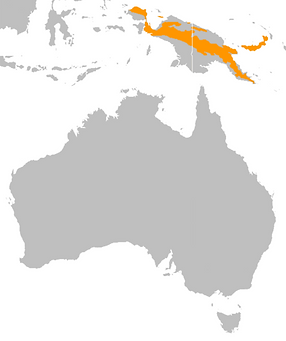Dwarf Cassowary(Casuarius bennetti)
They are also known as Bennett's cassowary, little cassowary, mountain cassowary or mooruk, is the smallest of the three species of cassowaries. The dwarf cassowary is a large bird but is slightly smaller than other living cassowaries (the southern cassowary and northern cassowary). It is between 99-150 cm long and weighs between 17.6-26 kg. It is a flightless bird with hard and stiff black plumage, a low triangular casque, pink cheek and red patches of skin on its blue neck. Compared to other cassowaries, the dwarf cassowary is shorter, with a tarsi length of 24.5 cm, with a slightly smaller bill, at 11-12.2 cm).

The feet are large and powerful, equipped with dagger-like claws on the inner toe. Both sexes are similar. Females have longer casques, brighter bare skin colour and are larger in size.
Habitat
The dwarf cassowary is distributed throughout mountain forests of New Guinea, New Britain, and Yapen Island, at elevations up to 3,300 m. In areas without other species of cassowaries, it will live in the lowlands also. Its range of occurrence range is approximately 258,000 km2.
Diet
The Dwarf Cassowary is an omnivorous bird and therefore eats a wide variety of both plants and animals in order to gain all the nutrients that it needs to survive. Dwarf Cassowaries mainly feed on fruits that have fallen to the ground from the trees, along with leaves, grasses, seeds, insects, spiders and other invertebrates.

Breeding
The breeding season begins in May or June and lasts until October or November. Breeding is an annual occurrence. Females may mate with more than one male during a season and must be healthy and well-nourished in order to lay multiple clutches of eggs. The clutch size of dwarf cassowaries is between 4 and 6 eggs. The incubation period lasts between 49 and 52 days. Young become independent in 7 to 16 months and sexually mature at around 4 years old.
Population
According to the IUCN Red List, they are classed as Least Concern(LC). The global population size has not been quantified, but the species is described as generally scarce, although locally common in north-eastern New Guinea. There are no data on population trends; however, the species is currently thought to be stable. There are fewer firearms in New Guinea compared to 30 years ago, and many uninhabited areas remaining where this species is believed to be doing well
Threats
Although probably tolerant of moderate habitat degradation, logging opens up previously inaccessible areas to hunters, with hunting thought to be unsustainable in some parts of the species's range . Road and airstrip construction similarly increases the penetration of the hunting market. Predation by pigs and dogs may be a threat to this species, but this has not yet been quantified. Despite suffering from heavy hunting pressure, it remains relatively common over a wide altitudinal range.
Conservation
Conservation Actions Underway
None are known.
Conservation Actions Proposed
Monitor populations in protected areas. Quantify the effects of hunting, logging and predation by pigs and dogs. Promote community-based hunting restrictions, particularly regarding the use of guns. Research population dynamics. Prevent habitat clearance.